Solar eclipse of July 22, 1990
| Solar eclipse of July 22, 1990 | |
|---|---|
 Map | |
| Type of eclipse | |
| Nature | Total |
| Gamma | 0.7597 |
| Magnitude | 1.0391 |
| Maximum eclipse | |
| Duration | 153 sec (2 m 33 s) |
| Coordinates | 65°12′N 168°54′E / 65.2°N 168.9°E |
| Max. width of band | 201 km (125 mi) |
| Times (UTC) | |
| Greatest eclipse | 3:03:07 |
| References | |
| Saros | 126 (46 of 72) |
| Catalog # (SE5000) | 9487 |
A total solar eclipse occurred on July 22, 1990. A solar eclipse occurs when the Moon passes between Earth and the Sun, thereby totally or partly obscuring the image of the Sun for a viewer on Earth. A total solar eclipse occurs when the Moon's apparent diameter is larger than the Sun's, blocking all direct sunlight, turning day into darkness. Totality occurs in a narrow path across Earth's surface, with the partial solar eclipse visible over a surrounding region thousands of kilometres wide.
In Finland the solar eclipse occurred during sunrise and enabled observation and photography without protective glasses, which was however hampered by strong clouds.[1] The Sun was totally eclipsed in Helsinki began at 06:03:07 local time.
Related eclipses
Solar eclipses 1990-1992
Each member in a semester series of solar eclipses repeats approximately every 177 days and 4 hours (a semester) at alternating nodes of the Moon's orbit.
| Solar eclipse series sets from 1990–1992 | ||||
|---|---|---|---|---|
| Ascending node | Descending node | |||
| Saros | Map | Saros | Map | |
| 121 | January 26, 1990 Annular |
126 | July 22, 1990 Total | |
| 131 | January 15, 1991 Annular |
136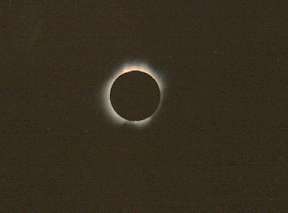 | July 11, 1991 Total | |
| 141 | January 4, 1992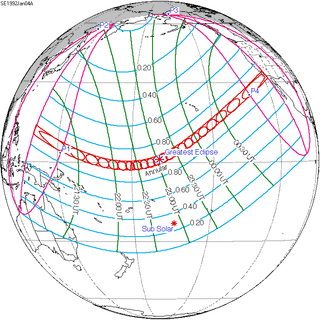 Annular |
146 | June 30, 1992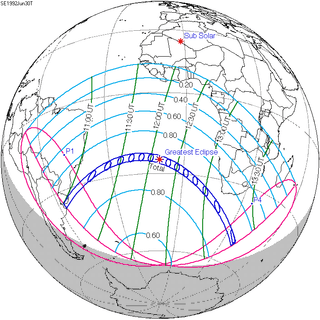 Total | |
| 151 | December 24, 1992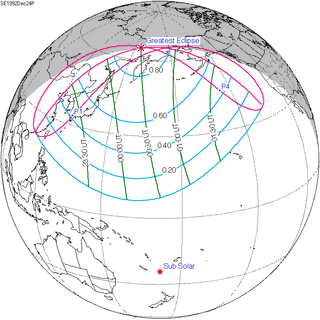 Partial |
|||
Saros 126
It is a part of Saros cycle 126, repeating every 18 years, 11 days, containing 71 events. The series started with partial solar eclipse on March 10, 1179. It contains annular eclipses from June 4, 1323 through April 4, 1810 and hybrid eclipses from April 14, 1828 through May 6, 1864. It contains total eclipses from May 17, 1882 through August 23, 2044. The series ends at member 72 as a partial eclipse on May 3, 2459. The longest duration of central eclipse (annular or total) was 5 minutes, 46 seconds of annularity on November 22, 1593. The longest duration of totality was 2 minutes, 36 seconds on July 10, 1972.[2]
| Series members 39–49 occur between 1901 and 2100 | ||
|---|---|---|
| 39 | 40 | 41 |
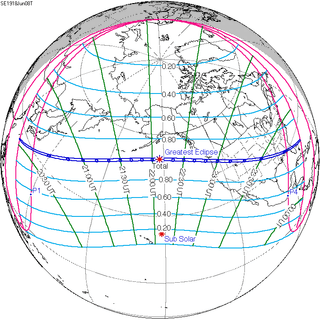 June 8, 1918 |
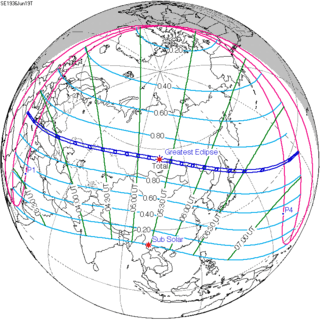 June 19, 1936 |
 June 30, 1954 |
| 42 | 43 | 44 |
 July 10, 1972 |
 July 22, 1990 |
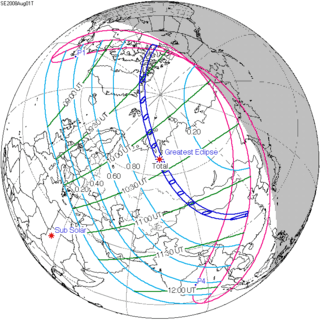 August 1, 2008 |
| 45 | 46 | 47 |
 August 12, 2026 |
 August 23, 2044 |
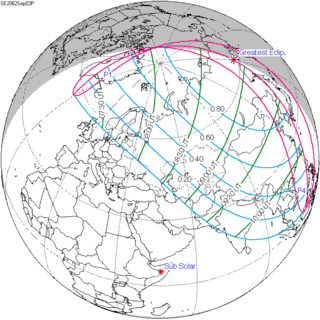 September 3, 2062 |
| 48 | 49 | |
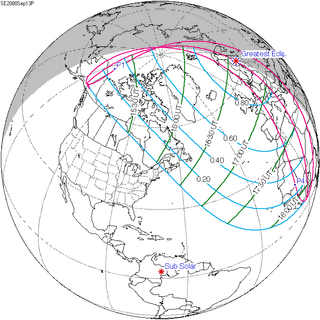 September 13, 2080 |
 September 25, 2098 | |
Metonic cycle
The metonic series repeats eclipses every 19 years (6939.69 days), lasting about 5 cycles. Eclipses occur in nearly the same calendar date. In addition the octon subseries repeats 1/5 of that or every 3.8 years (1387.94 days).
| 21 events between July 22, 1971 and July 22, 2047 | ||||
|---|---|---|---|---|
| July 21-22 | May 9-11 | February 26-27 | December 14-15 | October 2-3 |
| 116 | 118 | 120 | 122 | 124 |
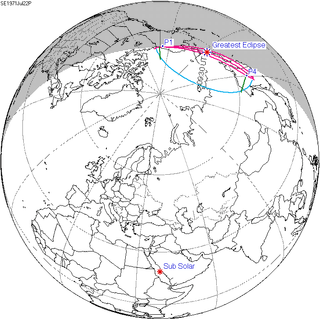 July 22, 1971 |
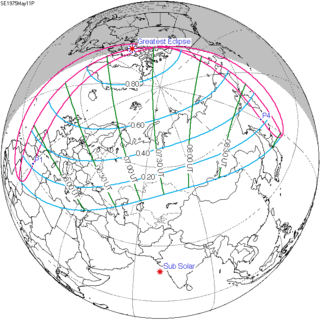 May 11, 1975 |
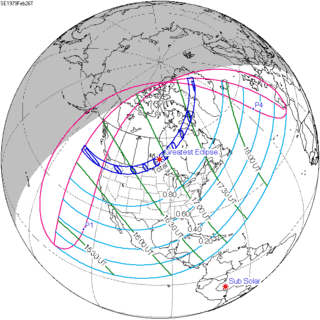 February 26, 1979 |
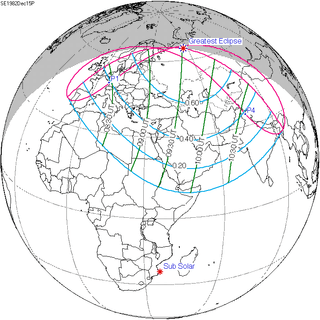 December 15, 1982 |
 October 3, 1986 |
| 126 | 128 | 130 | 132 | 134 |
 July 22, 1990 |
 May 10, 1994 |
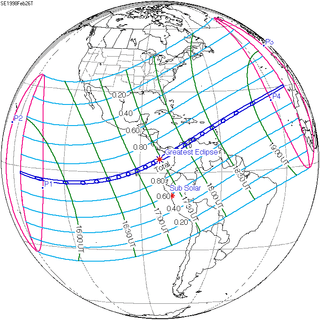 February 26, 1998 |
 December 14, 2001 |
 October 3, 2005 |
| 136 | 138 | 140 | 142 | 144 |
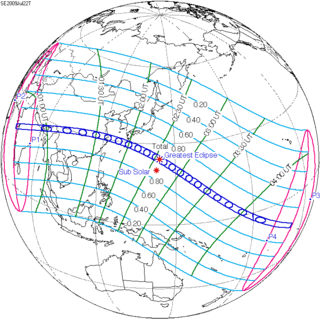 July 22, 2009 |
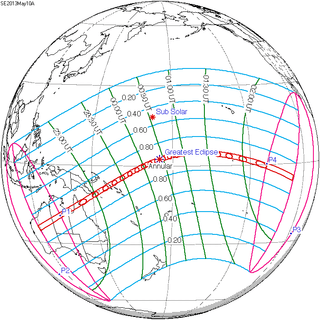 May 10, 2013 |
 February 26, 2017 |
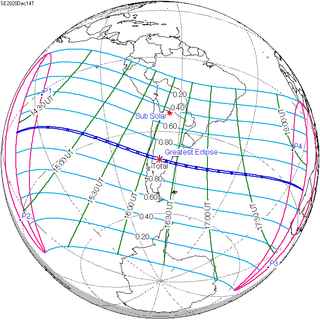 December 14, 2020 |
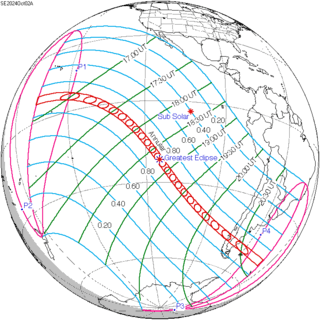 October 2, 2024 |
| 146 | 148 | 150 | 152 | 154 |
 July 22, 2028 |
 May 9, 2032 |
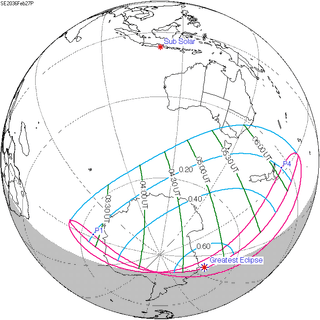 February 27, 2036 |
 December 15, 2039 |
 October 3, 2043 |
| 156 | ||||
 July 22, 2047 | ||||
Notes
- ↑ report and photos from Finland
- ↑ Solar_Saros_series_126, accessed October 2010
References
- Earth visibility chart and eclipse statistics Eclipse Predictions by Fred Espenak, NASA/GSFC
Photos:
- Prof. Druckmüller's eclipse photography site
- Druckmüller in Chukotka, Soviet Union
- in Russia
- in Russia (2)
- Russian scientist had no successful observation of the eclipse
| Wikimedia Commons has media related to Solar eclipse of July 22, 1990. |
